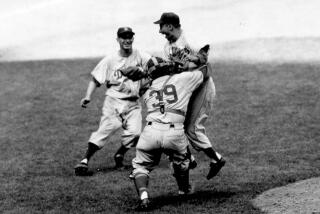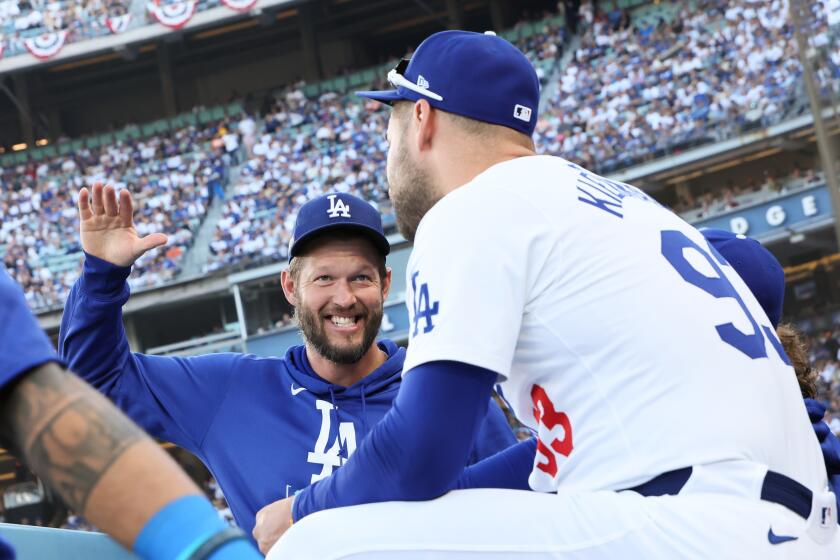Dodgers Dugout: The 25 greatest Dodgers of all time, No. 3: Vin Scully
Hi, and welcome to another edition of Dodgers Dugout. My name is Houston Mitchell and let’s get right to No. 3 in our countdown.
The 25 greatest Dodgers, No. 3: Vin Scully (1,806 first-place votes, 45,651 points)
“It’s time for Dodger baseball.”
Those five words were a signal to Dodgers fans to pull up a chair, settle down and listen to the greatest sports broadcaster in history call that day’s Dodger game.
Scully joined the Dodgers in 1950, working alongside Radio Hall of Famer and baseball legend Red Barber. In 1976, Dodgers fans voted Scully the “most memorable personality” in Los Angeles Dodgers history.
Scully must have been some sort of good-luck charm, because only five years after he joined the team, the Dodgers won their first World Series title, with Scully calling the game.
“On the last out of the game in the finale, I said, `Ladies and gentlemen, the Brooklyn Dodgers are the champions of the world.’ Then I stopped and didn’t say another thing. All winter long people asked me, `How could you have stayed so calm?’ Well, the truth is, I was so emotionally overwhelmed by it all that if I had to say another word I think I would have cried.”
When the Dodgers moved to L.A. in 1958, they played at the Coliseum, which wasn’t really designed for baseball and had some poor sight lines for the fans. Because some fans had such difficulty following the action there, and others had never watched much baseball, they began bringing their radios to games and listening while they were watching live, a practice that continues to this day at Dodger Stadium.
Scully was inducted into the broadcasters’ wing of the Baseball Hall of Fame in 1982, during his 33rd season with the team. It’s a good thing too, because he only had 34 more seasons to go.
Scully retired after the 2016 season. If Joe Davis, who essentially succeeded Scully, remains with the Dodgers as long as Scully did, then Davis’ last season with the team will be 2083.
For more on Scully, read this article.
Some of Scully’s most memorable calls and quotes:
“All year long they looked to him [Kirk Gibson] to light the fire and all year long he answered the demands. High fly ball into right field. She is gone! [pause] In a year that has been so improbable, the impossible has happened.”
“Sometimes it seems like he’s playing underwater.” —on Bobby Bonilla
“There’s a high bouncer over the mound, over second base, Mantilla’s up with it, throws low and wild ... Hodges scores, we go to Chicago! [crowd noise for a nice long while] The Cinderella team [1959 Los Angeles Dodgers] of the National League.”
“There’s a little roller up along first, behind the bag! It gets through Buckner! Here comes Knight and the Mets win it!” —1986 World Series
“When he runs, it’s all downhill.” —on Maury Wills
“Andre Dawson has a bruised knee and is listed as day-to-day [pause]. Aren’t we all?”
“Football is to baseball as blackjack is to bridge. One is the quick jolt. The other the deliberate, slow-paced game of skill, but never was a sport more ideally suited to television than baseball. It’s all there in front of you. It’s theater, really. The star is the spotlight on the mound, the supporting cast fanned out around him, the mathematical precision of the game moving with the kind of inevitability of Greek tragedy. With the Greek chorus in the bleachers!”
“He pitches as though he’s double-parked.” —on Bob Gibson
“He’s like a tailor; a little off here, a little off there and you’re done, take a seat.” —on Tom Glavine
“How good was Stan Musial? He was good enough to take your breath away.”
“It’s a mere moment in a man’s life between the All-Star Game and an old-timers’ game.”
“It’s a passing of a great American tradition. It is sad. I really and truly feel that. It will leave a vast window, to use a Washington word, where people will not get Major League Baseball and I think that’s a tragedy.” —on the last “NBC Game of the Week” on Oct. 9, 1989.
“I would come home to listen to a football game — there weren’t other sports on — and I would get a pillow and I would crawl under the radio, so that the loudspeaker and the roar of the crowd would wash all over me, and I would just get goose bumps like you can’t believe. And I knew that of all the things in this world that I wanted, I wanted to be that fella saying, whatever, home run, or touchdown. It just really got to me.”
“Roberto Clemente could field the ball in New York and throw out a guy in Pittsburgh.”
His famous call of the final inning of Sandy Koufax’s perfect game:
“Three times in his sensational career has Sandy Koufax walked out to the mound to pitch a fateful ninth where he turned in a no-hitter. But tonight, September the ninth, nineteen hundred and sixty-five, he made the toughest walk of his career, I’m sure, because through eight innings he has pitched a perfect game. He has struck out 11, he has retired 24 consecutive batters, and the first man he will look at is catcher Chris Krug, big right-hand hitter, flied to second, grounded to short. Dick Tracewski is now at second base and Koufax ready and delivers: curveball for a strike.
“Oh-and-one the count to Chris Krug. Out on deck to pinch-hit is one of the men we mentioned earlier as a possible, Joey Amalfitano. Here’s the strike one pitch to Krug: fastball, swung on and missed, strike two. And you can almost taste the pressure now. Koufax lifted his cap, ran his fingers through his black hair, then pulled the cap back down, fussing at the bill. Krug must feel it too as he backs out, heaves a sigh, took off his helmet, put it back on and steps back up to the plate. Tracewski is over to his right to fill up the middle, Kennedy is deep to guard the line. The strike two pitch on the way: fastball, outside, ball one. Krug started to go after it and held up and Torborg held the ball high in the air trying to convince Vargo [the umpire] but Eddie said no sir. One and two the count to Chris Krug. It is 9:41 p.m. on September the ninth. The one-two pitch on the way: curveball, tapped foul off to the left of the plate.
“The Dodgers defensively in this spine-tingling moment: Sandy Koufax and Jeff Torborg. The boys who will try and stop anything hit their way: Wes Parker, Dick Tracewski, Maury Wills and John Kennedy; the outfield of Lou Johnson, Willie Davis and Ron Fairly. And there’s twenty-nine thousand people in the ballpark and a million butterflies. Twenty nine thousand, one hundred and thirty-nine paid.
“Koufax into his windup and the one-two pitch: fastball, fouled back out of play. In the Dodger dugout Al Ferrara gets up and walks down near the runway, and it begins to get tough to be a teammate and sit in the dugout and have to watch. Sandy back of the rubber, now toes it. All the boys in the bullpen straining to get a better look as they look through the wire fence in left field. One and two the count to Chris Krug. Koufax, feet together, now to his windup and the one-two pitch: fastball outside, ball two. (Crowd booing on the tape.)
“A lot of people in the ballpark now are starting to see the pitches with their hearts. The pitch was outside, Torborg tried to pull it over the plate but Vargo, an experienced umpire, wouldn’t go for it. Two and two the count to Chris Krug. Sandy reading signs, into his windup, two-two pitch: fastball, got him swinging.
“Sandy Koufax has struck out twelve. He is two outs away from a perfect game.
“Here is Joe Amalfitano to pinch-hit for Don Kessinger. Amalfitano is from Southern California, from San Pedro. He was an original bonus boy with the Giants. Joey’s been around, and as we mentioned earlier, he has helped to beat the Dodgers twice, and on deck is Harvey Kuenn. Kennedy is tight to the bag at third, the fastball, a strike. Oh and one with one out in the ninth inning, 1-0, Dodgers. Sandy reading, into his windup and the strike one pitch: curveball, tapped foul, Oh and two. And Amalfitano walks away and shakes himself a little bit, and swings the bat. And Koufax with a new ball, takes a hitch at his belt and walks behind the mound.
“I would think that the mound at Dodger Stadium right now is the loneliest place in the world. Sandy fussing, looks in to get his sign, Oh and two to Amalfitano. The strike two pitch to Joe: fastball, swung on and missed, strike three. He is one out away from the promised land, and Harvey Kuenn is comin’ up.
“So Harvey Kuenn is batting for Bob Hendley. The time on the scoreboard is 9:44. The date, September the ninth, 1965, and Koufax working on veteran Harvey Kuenn. Sandy into his windup and the pitch, a fastball for a strike. He has struck out, by the way, five consecutive batters, and that’s gone unnoticed. Sandy ready and the strike one pitch: very high, and he lost his hat. He really forced that one. That’s only the second time tonight where I have had the feeling that Sandy threw instead of pitched, trying to get that little extra, and that time he tried so hard his hat fell off — he took an extremely long stride to the plate — and Torborg had to go up to get it.
“One and one to Harvey Kuenn. Now he’s ready: fastball, high, ball two. You can’t blame a man for pushing just a little bit now. Sandy backs off, mops his forehead, runs his left index finger along his forehead, dries it off on his left pants leg. All the while Kuenn just waiting. Now Sandy looks in. Into his windup and the two-one pitch to Kuenn: swung on and missed, strike two. It is 9:46 p.m.
“Two and two to Harvey Kuenn, one strike away. Sandy into his windup, here’s the pitch:
“Swung on and missed, a perfect game! (Crowd cheering for 38 seconds)
“On the scoreboard in right field it is 9:46 p.m. in the City of the Angels, Los Angeles, California. And a crowd of 29,139 just sitting in to see the only pitcher in baseball history to hurl four no-hit, no-run games. He has done it four straight years, and now he caps it: On his fourth no-hitter he made it a perfect game. And Sandy Koufax, whose name will always remind you of strikeouts, did it with a flourish. He struck out the last six consecutive batters. So, when he wrote his name in capital letters in the record books, that “K” stands out even more than the O-U-F-A-X.”
His final words as a Dodgers broadcaster:
“You know, friends, so many people have wished me congratulations on a 67-year career in baseball, and they’ve wished me a wonderful retirement with my family, and now, all I can do is tell you what I wish for you. May God give you, for every storm, a rainbow; for every tear, a smile; for every care, a promise; and a blessing in each trial. For every problem life seems, a faithful friend to share; for every sigh, a sweet song, and an answer for each prayer. You and I have been friends for a long time, but I know, in my heart, I’ve always needed you more than you’ve ever needed me, and I’ll miss our time together more than I can say. But, you know what, there will be a new day, and, eventually, a new year, and when the upcoming winter gives way to spring, ooh, rest assured, once again, it will be time for Dodger baseball. So, this is Vin Scully wishing you a pleasant good afternoon, wherever you may be.”
The list
Note: I received 8,382 ballots from newsletter readers who sent me their choices for the top 10 Dodgers of all time. Points were assigned based on ranking, with the first-place choice getting 12 points, second place getting 10, third place eight, down to one point for 10th place. After tabulating the ballots, I have been counting down the top 25 in points. I’ll get to No. 1 on March 29, the day the season opens. There will continue to be separate newsletters for any news that comes out of spring training.
And finally
Next up (on Thursday) are Nos. 1 and 2. There’s little doubt who the final two will be, the only question being will Frank McCourt finish first and Jamie McCourt second, or vice versa?
Have a comment or something you’d like to see in a future Dodgers newsletter? Email me and follow me on Twitter: @latimeshouston.
More to Read
Are you a true-blue fan?
Get our Dodgers Dugout newsletter for insights, news and much more.
You may occasionally receive promotional content from the Los Angeles Times.









